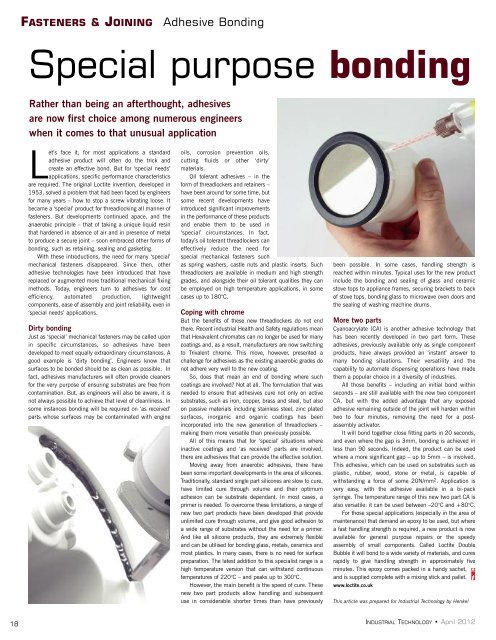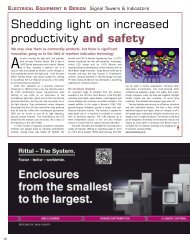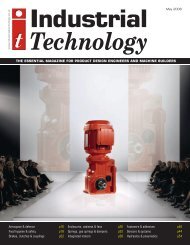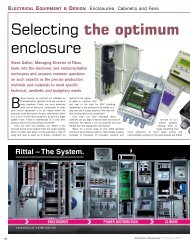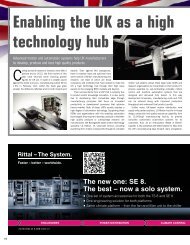machine building & automation - Industrial Technology Magazine
machine building & automation - Industrial Technology Magazine
machine building & automation - Industrial Technology Magazine
- No tags were found...
You also want an ePaper? Increase the reach of your titles
YUMPU automatically turns print PDFs into web optimized ePapers that Google loves.
FASTENERS & JOININGAdhesive BondingSpecial purpose bondingRather than being an afterthought, adhesivesare now first choice among numerous engineerswhen it comes to that unusual applicationLet’s face it, for most applications a standardadhesive product will often do the trick andcreate an effective bond. But for ‘special needs’applications, specific performance characteristicsare required. The original Loctite invention, developed in1953, solved a problem that had been faced by engineersfor many years – how to stop a screw vibrating loose. Itbecame a ‘special’ product for threadlocking all manner offasteners. But developments continued apace, and theanaerobic principle – that of taking a unique liquid resinthat hardened in absence of air and in presence of metalto produce a secure joint – soon embraced other forms ofbonding, such as retaining, sealing and gasketing.With these introductions, the need for many ‘special’mechanical fasteners disappeared. Since then, otheradhesive technologies have been introduced that havereplaced or augmented more traditional mechanical fixingmethods. Today, engineers turn to adhesives for costefficiency, automated production, lightweightcomponents, ease of assembly and joint reliability, even in‘special needs’ applications.Dirty bondingJust as ‘special’ mechanical fasteners may be called uponin specific circumstances, so adhesives have beendeveloped to meet equally extraordinary circumstances. Agood example is ‘dirty bonding’. Engineers know thatsurfaces to be bonded should be as clean as possible. Infact, adhesives manufacturers will often provide cleanersfor the very purpose of ensuring substrates are free fromcontamination. But, as engineers will also be aware, it isnot always possible to achieve that level of cleanliness. Insome instances bonding will be required on ‘as received’parts whose surfaces may be contaminated with engineoils, corrosion prevention oils,cutting fluids or other ‘dirty’materials.Oil tolerant adhesives – in theform of threadlockers and retainers –have been around for some time, butsome recent developments haveintroduced significant improvementsin the performance of these productsand enable them to be used in‘special’ circumstances. In fact,today’s oil tolerant threadlockers caneffectively reduce the need forspecial mechanical fasteners suchas spring washers, castle nuts and plastic inserts. Suchthreadlockers are available in medium and high strengthgrades, and alongside their oil tolerant qualities they canbe employed on high temperature applications, in somecases up to 180°C.Coping with chromeBut the benefits of these new threadlockers do not endthere. Recent industrial Health and Safety regulations meanthat Hexavalent chromates can no longer be used for manycoatings and, as a result, manufacturers are now switchingto Trivalent chrome. This move, however, presented achallenge for adhesives as the existing anaerobic grades donot adhere very well to the new coating.So, does that mean an end of bonding where suchcoatings are involved? Not at all. The formulation that wasneeded to ensure that adhesives cure not only on activesubstrates, such as iron, copper, brass and steel, but alsoon passive materials including stainless steel, zinc platedsurfaces, inorganic and organic coatings has beenincorporated into the new generation of threadlockers –making them more versatile than previously possible.All of this means that for ‘special’ situations whereinactive coatings and ‘as received’ parts are involved,there are adhesives that can provide the effective solution.Moving away from anaerobic adhesives, there havebeen some important developments in the area of silicones.Traditionally, standard single part silicones are slow to cure,have limited cure through volume and their optimumadhesion can be substrate dependant. In most cases, aprimer is needed. To overcome these limitations, a range ofnew two part products have been developed that provideunlimited cure through volume, and give good adhesion toa wide range of substrates without the need for a primer.And like all silicone products, they are extremely flexibleand can be utilised for bonding glass, metals, ceramics andmost plastics. In many cases, there is no need for surfacepreparation. The latest addition to this specialist range is ahigh temperature version that can withstand continuoustemperatures of 220°C – and peaks up to 300°C.However, the main benefit is the speed of cure. Thesenew two part products allow handling and subsequentuse in considerable shorter times than have previouslybeen possible. In some cases, handling strength isreached within minutes. Typical uses for the new productinclude the bonding and sealing of glass and ceramicstove tops to appliance frames, securing brackets to backof stove tops, bonding glass to microwave oven doors andthe sealing of washing <strong>machine</strong> drums.More two partsCyanoacrylate (CA) is another adhesive technology thathas been recently developed in two part form. Theseadhesives, previously available only as single componentproducts, have always provided an ‘instant’ answer tomany bonding situations. Their versatility and thecapability to automate dispensing operations have madethem a popular choice in a diversity of industries.All those benefits – including an initial bond withinseconds – are still available with the new two componentCA, but with the added advantage that any exposedadhesive remaining outside of the joint will harden withintwo to four minutes, removing the need for a postassemblyactivator.It will bond together close fitting parts in 20 seconds,and even where the gap is 3mm, bonding is achieved inless than 90 seconds. Indeed, the product can be usedwhere a more significant gap – up to 5mm – is involved.This adhesive, which can be used on substrates such asplastic, rubber, wood, stone or metal, is capable ofwithstanding a force of some 20N/mm 2 . Application isvery easy, with the adhesive available in a bi-packsyringe. The temperature range of this new two part CA isalso versatile: it can be used between –20°C and +80°C.For those special applications (especially in the area ofmaintenance) that demand an epoxy to be used, but wherea fast handling strength is required, a new product is nowavailable for general purpose repairs or the speedyassembly of small components. Called Loctite DoubleBubble it will bond to a wide variety of materials, and curesrapidly to give handling strength in approximately fiveminutes. This epoxy comes packed in a handy sachet,and is supplied complete with a mixing stick and pallet.www.loctite.co.ukThis article was prepared for <strong>Industrial</strong> <strong>Technology</strong> by Henkel18INDUSTRIAL TECHNOLOGY • April 2012


